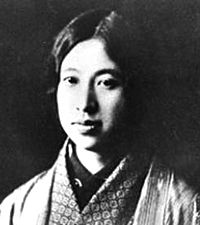Hiratsuka Raichō facts for kids
Quick facts for kids
Hiratsuka Raichō
|
|
|---|---|

Raichō, from her autobiography
|
|
| Born | Haru Hiratsuka February 10, 1886 Tokyo, Japan |
| Died | May 24, 1971 (aged 85) |
| Nationality | Japanese |
Hiratsuka Raichō (平塚 らいちょう, February 10, 1886 – May 24, 1971) was an important writer, journalist, and activist from Japan. She was a pioneer in the feminist movement in Japan, fighting for women's rights and equality. She also became known for her work as a pacifist, promoting peace.
Contents
Early Life and Education
Hiratsuka Haru was born in Tokyo in 1886. Her father was a high-ranking government worker. She went to Japan Women's University in 1903.
During her studies, Hiratsuka became interested in European ideas and Zen Buddhism. She became a dedicated follower of Zen Buddhism. A Swedish feminist writer named Ellen Key greatly influenced her. Hiratsuka even translated some of Key's books into Japanese. She was also inspired by the strong, independent main character in Henrik Ibsen's play A Doll's House.
Starting Seitō Magazine
After university, Hiratsuka founded Japan's first magazine written only by women. This was in 1911, and the magazine was called Seitō (青鞜), which means "Bluestocking."
She started the first issue with a famous quote: "In the beginning, woman was the sun" (「元始、女性は太陽であった」). This quote referred to Amaterasu, a sun goddess in the Shinto religion. It meant that women originally had spiritual freedom, but had lost it.
Hiratsuka chose the pen name "Raichō," meaning "Thunderbird." She called for a "spiritual revolution" for women. At first, the magazine focused on literature. But soon, it shifted to discussing women's issues. Famous poet and women's rights supporter Yosano Akiko was one of the writers for Seitō.
Challenges and Public Opinion
Many Japanese people learned about modern feminist ideas through Seitō. However, the media often criticized the magazine. They suggested that Raichō and her friends were just seeking fame.
Exaggerated stories about their lives and their nonconformist ideas spread in the press. This turned public opinion against the magazine. Raichō had to write strong defenses of her beliefs. In April 1913, she wrote an essay called "To the Women of the World" (「世の婦人たちに」). In it, she rejected the traditional role of women as ryōsai kenbo (良妻賢母, meaning "Good wife and wise mother"). She questioned how many women married without love just for financial security.
This independent thinking put Seitō in conflict with society and the government. It led to censorship of women's magazines that "disturbed public order." It also targeted magazines that introduced "Western ideas about women" that were seen as not fitting with Japanese culture. The magazine stopped publishing in 1915. However, it had already made Hiratsuka a leading figure in Japan's women's movement.
Later Activism and Peace Efforts
In 1914, Hiratsuka began living with artist Okumura Hiroshi. They had two children and later married in 1941.
Maternity Protection Debate
From 1918 to 1919, a big debate happened about women's financial independence. Yosano Akiko argued that women should be financially independent. Hiratsuka, influenced by Ellen Key, believed that complete independence was hard for women at that time. She argued that the government should provide financial help for mothers. This would help women have a stronger place in society, especially working women. This debate became known as the Maternity Protection Controversy.
Founding the New Women's Association
In 1920, Hiratsuka investigated the tough working conditions of women in textile factories. This made her even more determined to fight for change. She founded the New Women's Association (新婦人協会, Shin-fujin kyokai) with Ichikawa Fusae.
Their group worked hard to change a law called Article 5 of the Police Security Regulations. This law, from 1900, stopped women from joining political groups or attending political meetings. Thanks to their efforts, the law was overturned in 1922. However, women in Japan still could not vote at that time.
Postwar Peace Movement
Hiratsuka joined the cooperative movement in the 1930s. She believed this was the best way to include many people in social reform. For some years, she stepped back from public life due to debts and her partner's health. But she continued to write and give lectures.
After World War II, she became a public figure again through the peace movement. In 1950, after the Korean War began, she traveled to the United States. She went with writer Nogami Yaeko and other Japanese women activists. They asked the US Secretary of State Dean Acheson to create a system where Japan could remain neutral and peaceful.
Hiratsuka continued to fight for women's rights after the war. In 1963, she founded the New Japan Women's Association (新日本婦人の会) with Nogami and artist Chihiro Iwasaki. She kept writing and lecturing until her death in 1971.
Legacy
Hiratsuka Raichō is mainly remembered for leading the Seitō group. She was a very important person in the women's movement in early 20th-century Japan. Her ideas inspired many, including Korean feminist author Na Hye-sok and social critic Itō Noe. Her postwar organization, the New Japan Women's Organization, is still active today.
Selected works
Original works
- 『円窓より』 (Marumado yori, The View from the Round Window)
- 『元始、女性は太陽であった』 (Genshi, josei wa taiyō de atta, In The Beginning Woman Was The Sun)
- 『私の歩いた道』 (Watakushi no aruita michi, The Road I Walked)
Translations
- Ellen Karolina Key, The Renaissance of Motherhood (『母性の復興』, Bosei no fukkō)
- Ellen Karolina Key, Love and Marriage (『愛と結婚』, Ai to kekkon)
- Teruko Craig, In the Beginning, Woman Was the Sun – The Autobiography of a Japanese Feminist(『元始、女性は太陽であった』, Genshi, josei wa taiyō de atta)
Images for kids
See also
 In Spanish: Raichō Hiratsuka para niños
In Spanish: Raichō Hiratsuka para niños


